Literary papers | Witi Ihimaera’s ‘The Whale Rider’
Lindsay Bilodeau, Assistant Curator, shares highlights from Witi Ihimaera’s annotated copy of ‘The Whale Rider’ revealing, the author’s reflections on his work and the personal connections woven into the storytelling in his worldwide bestselling novel.
Literary annotations
Literary annotations are additions made to written works that add to the story of those works. They give us a look into the way a writer thought through their story, their influences, and what they might think about their work years after its publication.
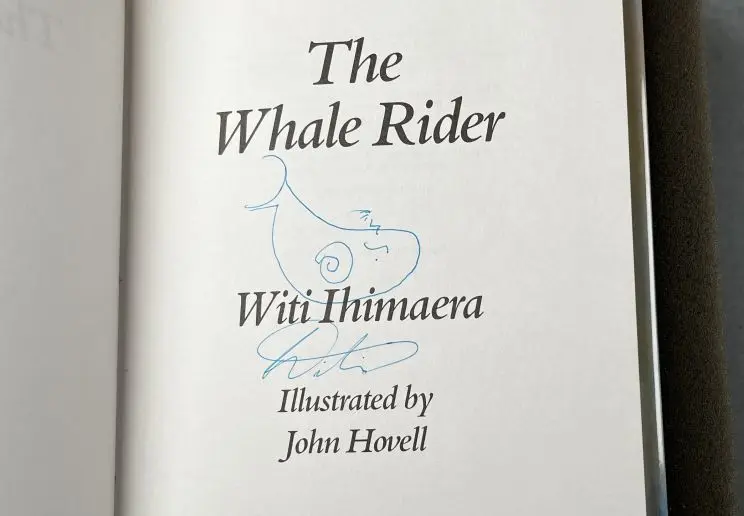
Witi Ihimaera’s signature on the title page of this special annotated copy of The Whale Rider (MSX-10209). Alexander Turnbull Library.
In this edition of our series on the literary papers in the Alexander Turnbull Library’s collection, I look at a beautifully annotated copy of The Whale Rider by Witi Ihimaera.
In the mid-1980s, while living in New York, Witi Ihimaera wrote The Whale Rider, a story centered in Mātauranga Māori and on the legend of Paikea. The novel, since translated widely and adapted into film and stage productions, was first published in 1987. In 2021 the Alexander Turnbull Library acquired this first-edition copy of the novel, annotated by Ihimaera, as part of a charity auction.
The annotations are detailed, some telling personal stories and some explaining the choices Ihimaera made while writing the novel. One, for example, notes that the novel was inspired by a whale that swam up the Hudson River while Ihimaera was in New York.

The Library's annotated copy of Witi Ihimaera’s The Whale Rider (MSX-10209).
Representing Indigenous culture
I would be lying if I said that Witi Ihimaera’s The Whale Rider wasn’t one of the reasons I was so enchanted by the concept of Aotearoa New Zealand. In this story, the power of Māori storytelling is clear, and as a young Indigenous girl living in Canada, it was unlike anything I had ever experienced in the books I read or movies I watched.
I had never read a book or watched a film that I felt represented an Indigenous culture in a relatable way. Because of this, I watched and re-watched the 2002 adaptation of this novel, and it never lost its magic or its melancholy beauty.
Now, as an adult living in Aotearoa, it holds even more significance to me. Not only do I have a much better understanding of the mātauranga and tikanga Māori in which it is grounded, but I also know what it feels like to try to tell a story that is uniquely Indigenous. When I was writing my PhD thesis, I made sure to centre it in the traditional knowledge and stories of my people, the Anishinaabe, and that helped me connect with my work. I can imagine that writing in such a personal way might have also helped Ihimaera feel connected with this novel.
When I began looking at the Alexander Turnbull Library’s annotated copy of The Whale Rider, I was struck by Ihimaera’s grounding in his identity and the stories of his people. His annotations highlight how much of himself and his connection to his home and people he put into the novel.
As an Indigenous person, it feels important to me that we find ways to remind the world that our stories are also our histories. They tell us how our ancestors lived, why they lived that way, and how we might move forward in the world in a way that is respectful not only of our ancestors but of our descendants. The Whale Rider and the annotations Ihimaera added to it do this in a way that sometimes seems effortless, and working with this collection item has been a joy for that reason.
An annotation on the dedication page reads: “My daughters Jess & Liv were 11 & 9 respectively when they came to visit me in New York during that incredible summer of 1986. Incredible for two reasons: Jess's pained question to me after we had seen a number of films ... She asked me, ‘Why are all the main stars boys, can't girls be heroes, too?’. That same summer a whale was sighted in the Hudson River. I saw it, tears sprang to my eyes, I wrote ‘The Whale Rider’ and made the whale rider a young girl...”
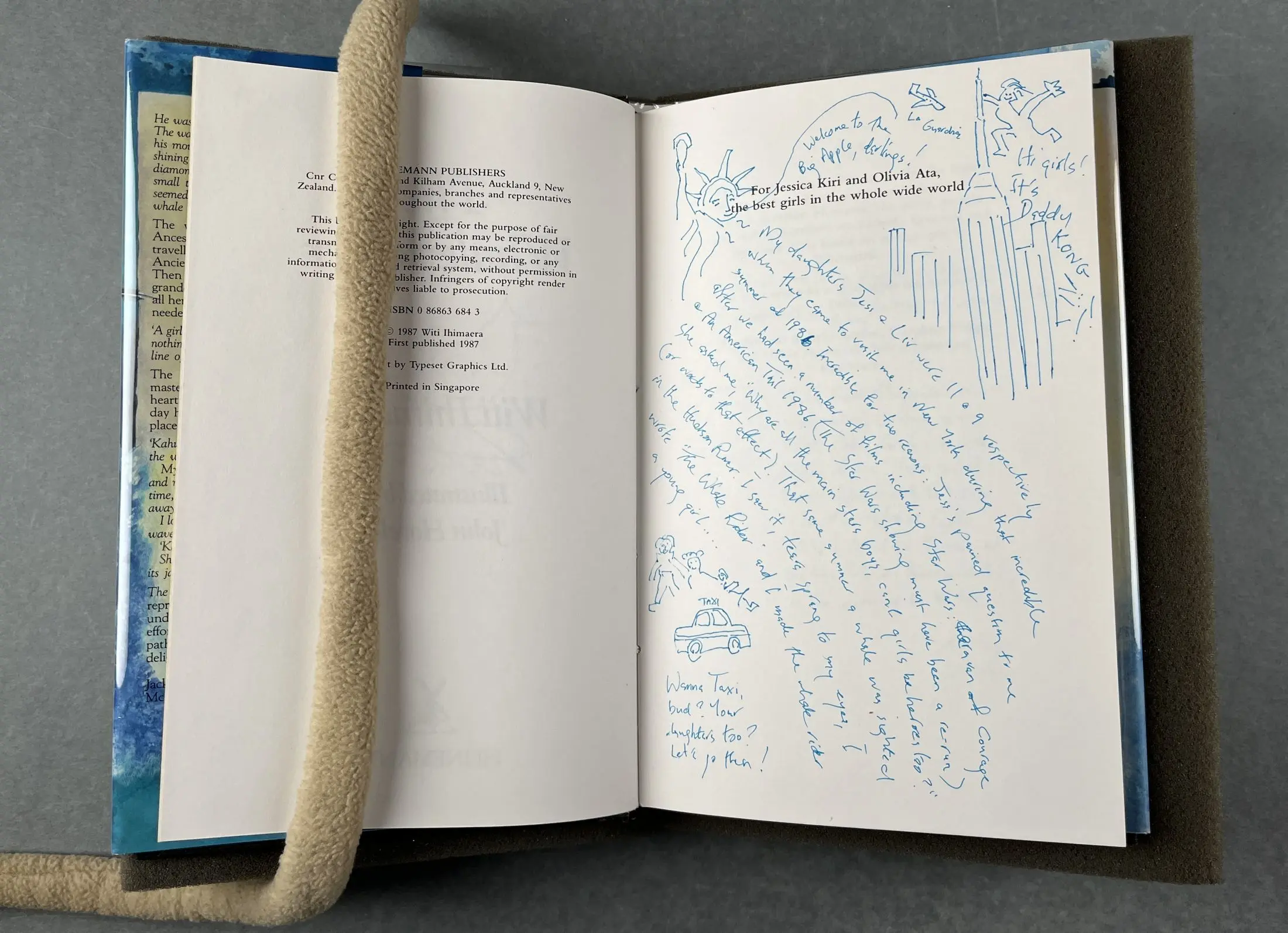
Indigenous knowledge as form
Ihimaera’s annotations show his connection to Mātauranga Māori early in this novel. On the table of contents, he writes: “... I like to think of this as the indigenous structure for the Western novel and have applied it in all my work”. This is in reference to the structure of the novel around seasons, and reminds the reader of the story’s connection to nature and Māori connections with Aotearoa. In this annotation, Ihimaera shows that his Maori identity is not only present in his work but that it guides and structures his novels.
His annotations also explain that the novel isn’t meant to follow a linear, Western structure. Instead, he writes, it is a waiata. Structuring the story in this way means that he can honour a different form of storytelling, a more Māori form. The story curves around like a koru and stretches out into a sort of whirlpool, as seen in his drawings on page 49.
He also illustrates in his annotations that, like the discussion his characters have about the whale, the novel is meant to cross the boundaries between real and supernatural, and its multiple timelines and switching perspectives between humans and whales shows this.
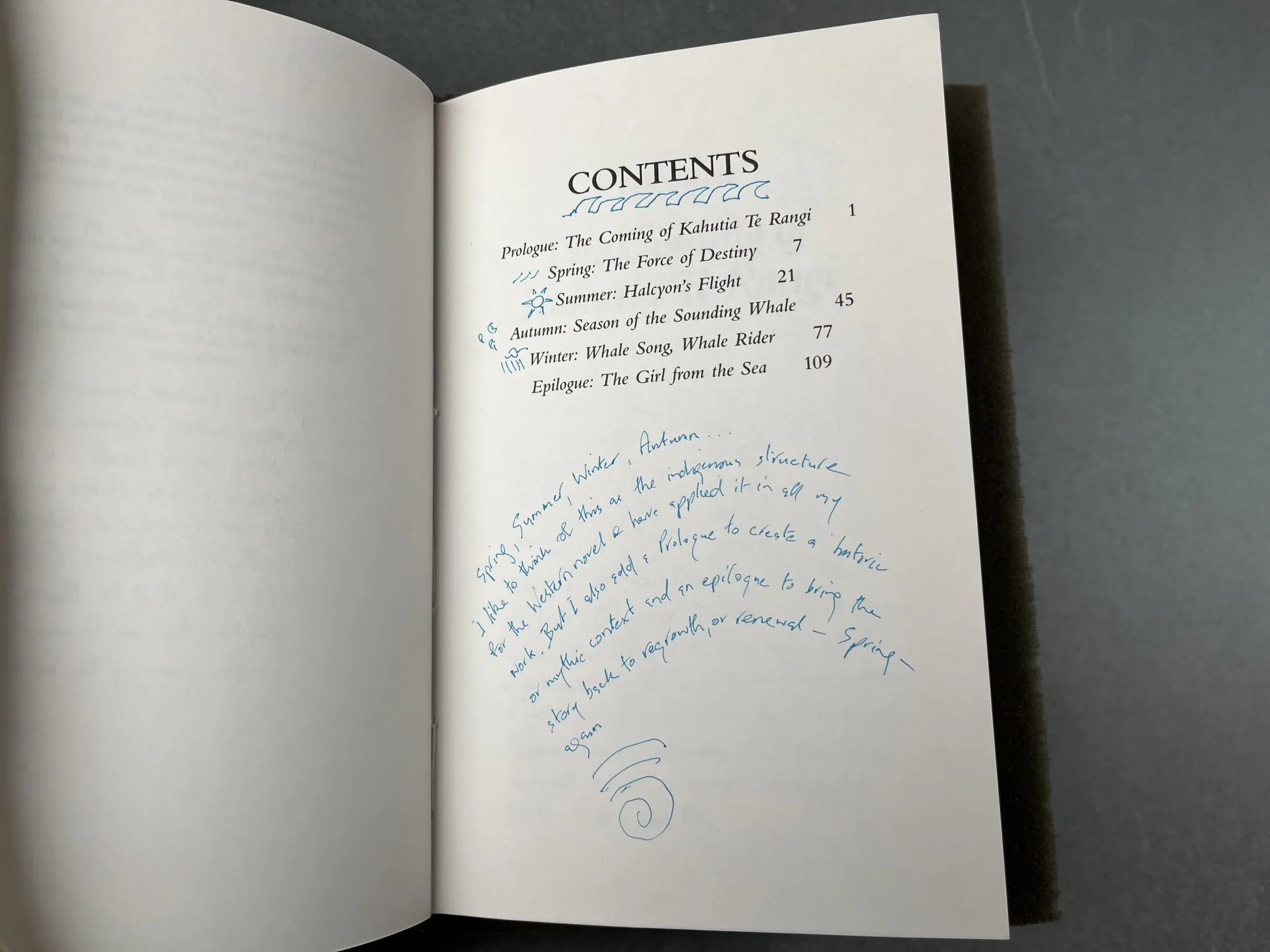
An annotation under the table of contents reads: "Spring, Summer, Winter, Autumn... I like to think of this as the indigenous structure for the Western novel & have applied it in all my work..."
Connections to his own life
I can personally attest to the fact that as an Indigenous writer, my family and relatives (both blood-related and those connected to me in other ways) are the foundation of my work. The very sweet and personal annotations that Ihimaera has added to this collection item suggest that his work is similarly informed by his relatives.
The annotations make clear how personally connected Ihimaera was to this story and perhaps to a lot of his work. Annotations like the note about his daughters on the dedication page speak to how he created the character of Kahu. It’s clear when you read the novel that the character is based on Ihimaera’s experience raising daughters, and seeing these annotations makes that connection even clearer.
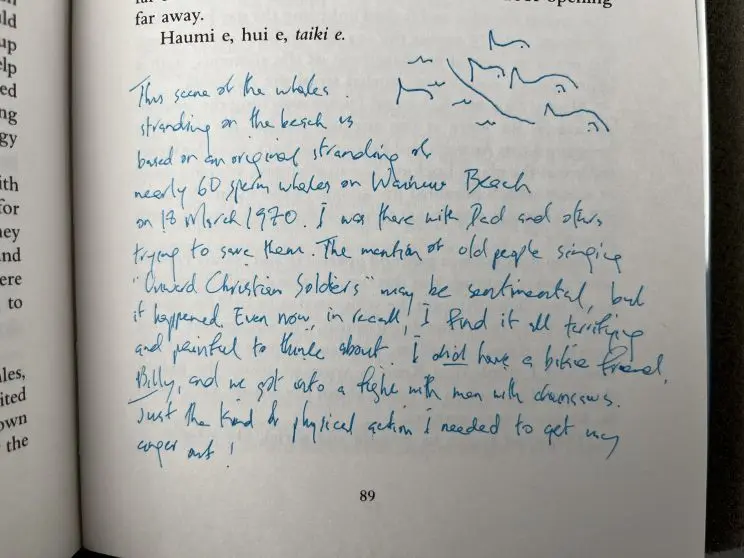
This annotation on page 89 reads: "The scene of the whales stranding on the beach is based on an original stranding of nearly 60 sperm whales on Wainui Beach on 18 March 1970. I was there with Dad and others trying to save them. The mention of old people singing 'Onwards Christian Soldiers' may be sentimental, but it happened. Even now, in recall, I find it all terrifying and painful to think about..."
He also wrote, in one annotation, that like the character in his book, Ihimaera himself had a Nanny Flowers. I’m not sure if she ever rode on a motorcycle like her fictional namesake, but this annotation shows just how much of Ihimaera’s own life experience went into forming this story and his characters.
I’m a particularly big fan of this annotation because the doodle of Rawiri (or perhaps Witi himself) taking Nanny Flowers out on a motorcycle reminds me of some of my own family stories, like the time my great-grandmother rode a scooter around our family Christmas party.
These annotations make the story so much more personal. They’re lovely and charming. Annotations have that sort of power to make the work more approachable and to highlight how relationships and personal connections can influence a writer’s work.
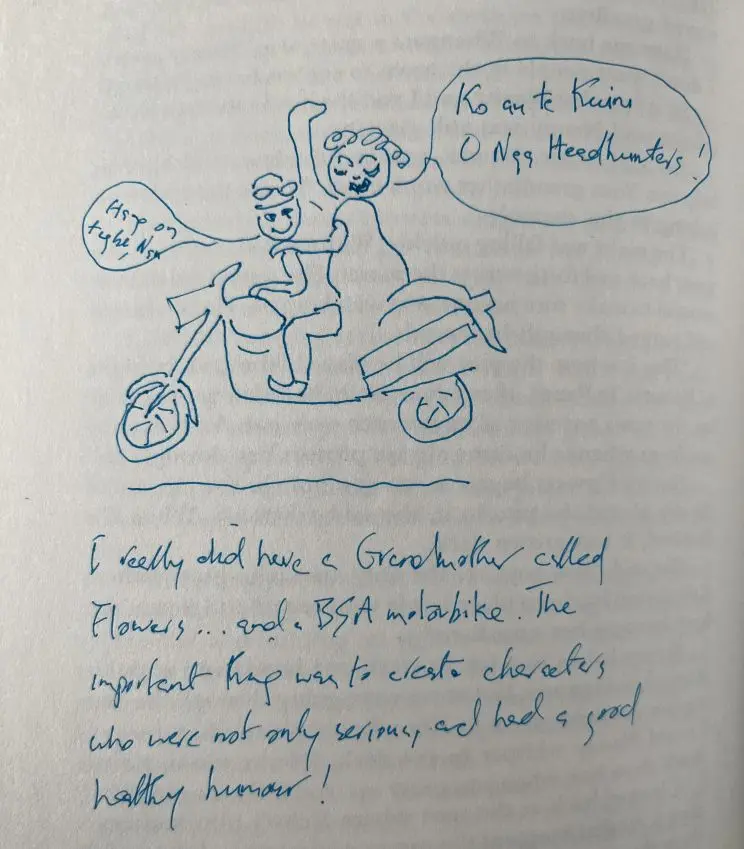
The annotation below the sketch of the motorbike reads: "I really did have a Grandmother called Flowers... And a BSA motorbike. The important thing was to create characters who were not only serious, and had a good healthy humour!"
Weaving Stories
Not only is the content of the annotations focused on Māori stories and stories about Ihimaera’s own life and family, but even the way he’s annotated the book speaks to his whakapapa Māori. His annotations are frequently written in slanted lines, meeting other sentences and paragraphs in the middle of the page, making his sentences look like a piece of weaving.
These woven annotations also mirror the way Ihimaera weaves multiple stories and time periods throughout the novel, with the narration by Rawiri telling the story of Kahu woven with the stories of the whales that guide the novel. Ihimaera also uses curved shapes around his annotations, calling upon the imagery of the koru or having his words surrounded by lines so that they move like water.
The form of his annotations reminds the reader of the Maori grounding and the settings of his story, making them an amazing and powerful addition to the novel.
Ihimaera’s annotations are often written in slanted lines, meeting other sentences and paragraphs in the middle of the page, making his sentences look like a piece of weaving. These woven annotations also mirror the way he weaves multiple stories and time periods throughout the novel.
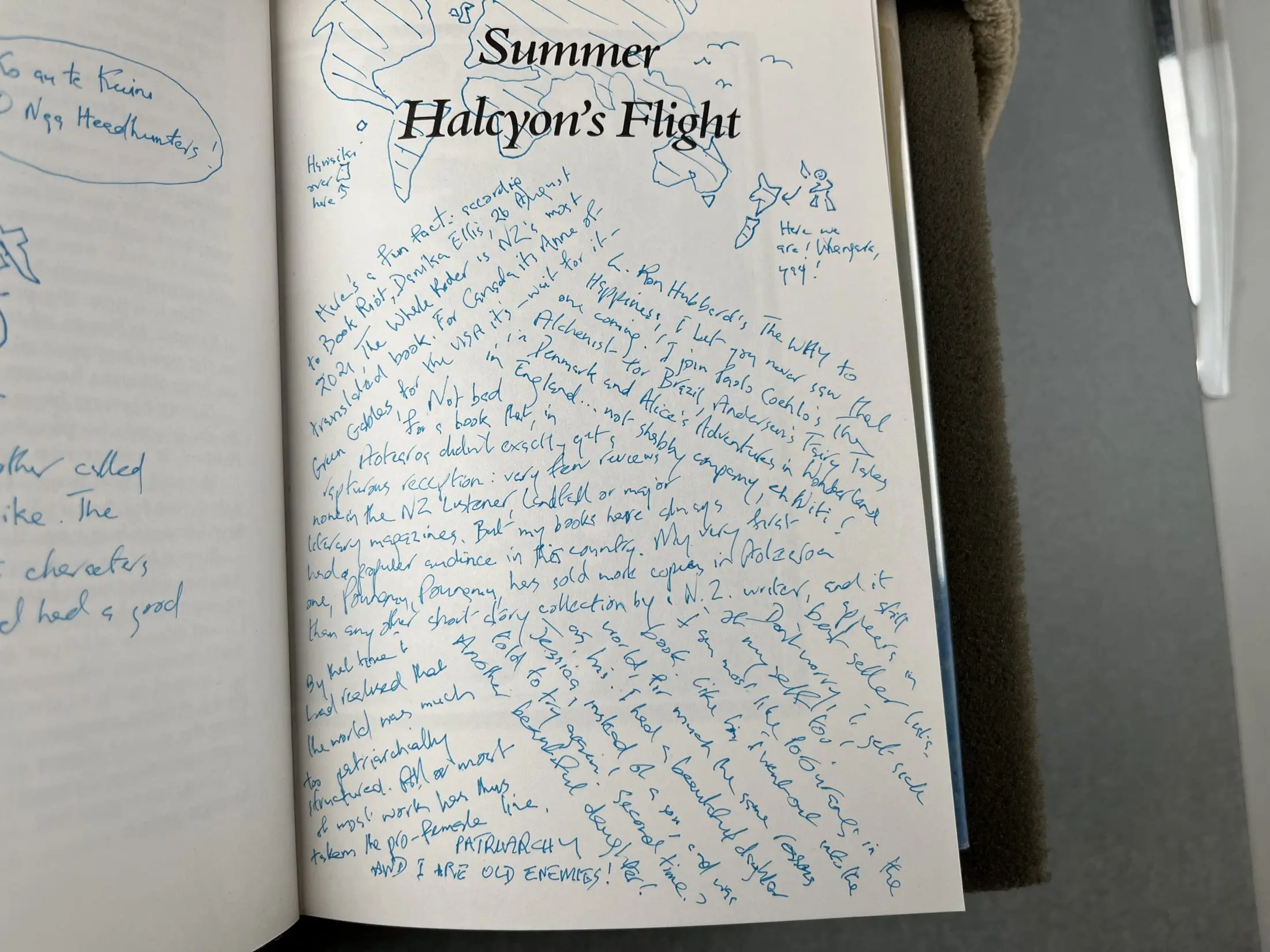
Conclusions
Witi Ihimaera’s annotations in this first edition of The Whale Rider remind me of the power of Indigenous storytelling. Whether he meant to or not, his words in this collection item have inspired me in my work and in my pursuit of telling Indigenous stories.
The magic of The Whale Rider is expanded on by Ihimaera’s 2021 annotations. They show that this magic comes from his knowledge, his life, and the crossing between what’s real and what’s fantasy. Ihimaera’s annotations also speak to ways Indigenous writers tell stories and structure stories around traditional knowledge systems, in this case, Mātauranga Māori.
Ihimaera’s annotations highlight the ability of Indigenous storytellers to remind us of our past and guide us into the future. The way he explains the structure of his work (and his annotations) shows how grounded Ihimaera seeks to be in mātauranga and tikanga Māori, and this helps him centre his writing.
I think that these annotations serve as a great example of how I and other Indigenous writers might incorporate our Indigenous knowledge and voices into our works.
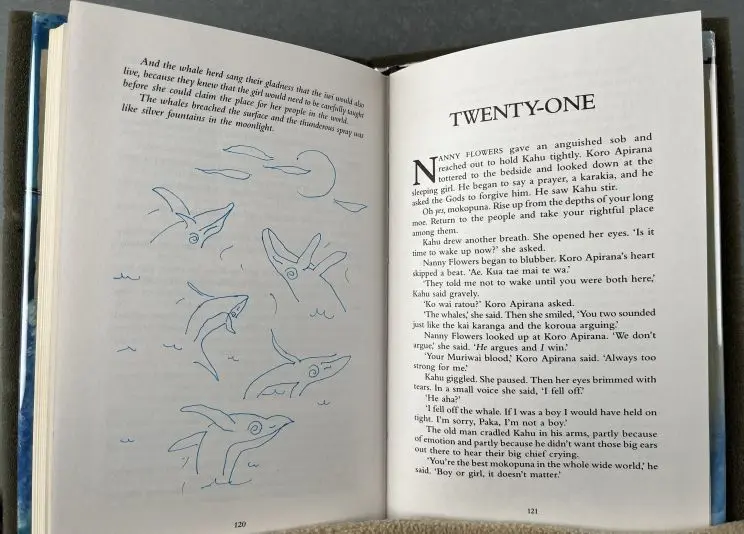
View the annotated copy of The Whale Rider
If you are visiting Wellington you can arrange to view this incredible collection item. Before you come, get in touch using the ‘Send and enquiry’ button on the website record page in the link below.
The Whale Rider annotated edition (MSX-10209)
Literary Papers blog series
The Literary Papers blog series highlights collection items from the Manuscripts Collection at the Alexander Turnbull Library.